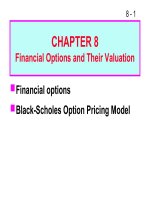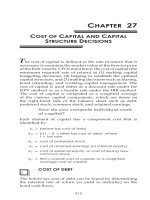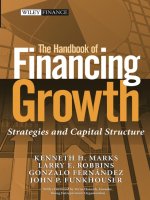Chapter 16 financial leverage and capital structure policy
Bạn đang xem bản rút gọn của tài liệu. Xem và tải ngay bản đầy đủ của tài liệu tại đây (475.96 KB, 47 trang )
Chapter 16
Financial Leverage and
Capital Structure
Policy
McGraw-Hill/Irwin
Copyright © 2010 by The McGraw-Hill Companies, Inc. All rights reserved.
Key Concepts and Skills
•
Understand the effect of financial
leverage on cash flows and the cost
of equity
•
Understand the impact of taxes and
bankruptcy on capital structure
choice
•
Understand the basic components of
the bankruptcy process
16-2
Chapter Outline
•
The Capital Structure Question
•
The Effect of Financial Leverage
•
Capital Structure and the Cost of Equity Capital
•
M&M Propositions I and II with Corporate Taxes
•
Bankruptcy Costs
•
Optimal Capital Structure
•
The Pie Again
•
The Pecking-Order Theory
•
Observed Capital Structures
•
A Quick Look at the Bankruptcy Process
16-3
Capital Restructuring
•
We are going to look at how changes in capital
structure affect the value of the firm, all else equal
•
Capital restructuring involves changing the amount
of leverage a firm has without changing the firm’s
assets
•
The firm can increase leverage by issuing debt
and repurchasing outstanding shares
•
The firm can decrease leverage by issuing new
shares and retiring outstanding debt
16-4
Choosing a Capital
Structure
•
What is the primary goal of financial
managers?
–
Maximize stockholder wealth
•
We want to choose the capital structure that
will maximize stockholder wealth
•
We can maximize stockholder wealth by
maximizing the value of the firm or
minimizing the WACC
16-5
The Effect of Leverage
•
How does leverage affect the EPS and ROE of a
firm?
•
When we increase the amount of debt financing,
we increase the fixed interest expense
•
If we have a really good year, then we pay our
fixed cost and we have more left over for our
stockholders
•
If we have a really bad year, we still have to pay
our fixed costs and we have less left over for our
stockholders
•
Leverage amplifies the variation in both EPS and
ROE
16-6
Example: Financial Leverage,
EPS and ROE – Part I
•
We will ignore the effect of taxes at this
stage
•
What happens to EPS and ROE when we
issue debt and buy back shares of stock?
Financial Leverage Example
16-7
Example: Financial Leverage,
EPS and ROE – Part II
•
Variability in ROE
–
Current: ROE ranges from 6% to 20%
–
Proposed: ROE ranges from 2% to 30%
•
Variability in EPS
–
Current: EPS ranges from $0.60 to $2.00
–
Proposed: EPS ranges from $0.20 to $3.00
•
The variability in both ROE and EPS
increases when financial leverage is
increased
16-8
Break-Even EBIT
•
Find EBIT where EPS is the same under
both the current and proposed capital
structures
•
If we expect EBIT to be greater than the
break-even point, then leverage may be
beneficial to our stockholders
•
If we expect EBIT to be less than the
break-even point, then leverage is
detrimental to our stockholders
16-9
Example: Break-Even EBIT
( )
$1.00
500,000
500,000
EPS
$500,000EBIT
500,0002EBITEBIT
250,000EBIT
250,000
500,000
EBIT
250,000
250,000EBIT
500,000
EBIT
==
=
−=
−
=
−
=
Break-even Graph
16-10
Example: Homemade Leverage
and ROE
•
Current Capital
Structure
•
Investor borrows $500
and uses $500 of her own
to buy 100 shares of stock
•
Payoffs:
–
Recession: 100(0.60) - .
1(500) = $10
–
Expected: 100(1.30) - .
1(500) = $80
–
Expansion: 100(2.00) - .
1(500) = $150
•
Mirrors the payoffs from
purchasing 50 shares of
the firm under the
proposed capital structure
•
Proposed Capital
Structure
•
Investor buys $250 worth of
stock (25 shares) and $250
worth of bonds paying 10%.
•
Payoffs:
–
Recession: 25(.20) + .
1(250) = $30
–
Expected: 25(1.60) + .
1(250) = $65
–
Expansion: 25(3.00) + .
1(250) = $100
•
Mirrors the payoffs from
purchasing 50 shares under
the current capital structure
16-11
Capital Structure Theory
•
Modigliani and Miller (M&M)Theory of
Capital Structure
–
Proposition I – firm value
–
Proposition II – WACC
•
The value of the firm is determined by the
cash flows to the firm and the risk of the
assets
•
Changing firm value
–
Change the risk of the cash flows
–
Change the cash flows
16-12
Capital Structure Theory Under
Three Special Cases
•
Case I – Assumptions
–
No corporate or personal taxes
–
No bankruptcy costs
•
Case II – Assumptions
–
Corporate taxes, but no personal taxes
–
No bankruptcy costs
•
Case III – Assumptions
–
Corporate taxes, but no personal taxes
–
Bankruptcy costs
16-13
Case I – Propositions I and II
•
Proposition I
–
The value of the firm is NOT affected by
changes in the capital structure
–
The cash flows of the firm do not
change; therefore, value doesn’t
change
•
Proposition II
–
The WACC of the firm is NOT affected
by capital structure
16-14
Case I - Equations
•
WACC = R
A
= (E/V)R
E
+ (D/V)R
D
•
R
E
= R
A
+ (R
A
– R
D
)(D/E)
–
R
A
is the “cost” of the firm’s business risk, i.e.,
the risk of the firm’s assets
–
(R
A
– R
D
)(D/E) is the “cost” of the firm’s financial
risk, i.e., the additional return required by
stockholders to compensate for the risk of
leverage
16-15
Figure 16.3
16-16
Case I - Example
•
Data
–
Required return on assets = 16%; cost of debt = 10%;
percent of debt = 45%
•
What is the cost of equity?
–
R
E
= 16 + (16 - 10)(.45/.55) = 20.91%
•
Suppose instead that the cost of equity is 25%,
what is the debt-to-equity ratio?
–
25 = 16 + (16 - 10)(D/E)
–
D/E = (25 - 16) / (16 - 10) = 1.5
•
Based on this information, what is the percent of
equity in the firm?
–
E/V = 1 / 2.5 = 40%
16-17
The CAPM, the SML and
Proposition II
•
How does financial leverage affect systematic
risk?
•
CAPM: R
A
= R
f
+ β
A
(R
M
– R
f
)
–
Where β
A
is the firm’s asset beta and measures the
systematic risk of the firm’s assets
•
Proposition II
–
Replace R
A
with the CAPM and assume that the debt is
riskless (R
D
= R
f
)
–
R
E
= R
f
+ β
A
(1+D/E)(R
M
– R
f
)
16-18
Business Risk and
Financial Risk
•
R
E
= R
f
+ β
A
(1+D/E)(R
M
– R
f
)
•
CAPM: R
E
= R
f
+ β
E
(R
M
– R
f
)
β
E
= β
A
(1 + D/E)
•
Therefore, the systematic risk of the stock
depends on:
–
Systematic risk of the assets, β
A
, (Business
risk)
–
Level of leverage, D/E, (Financial risk)
16-19
Case II – Cash Flow
•
Interest is tax deductible
•
Therefore, when a firm adds debt, it
reduces taxes, all else equal
•
The reduction in taxes increases the
cash flow of the firm
•
How should an increase in cash
flows affect the value of the firm?
16-20
Case II - Example
Unlevered Firm Levered Firm
EBIT 5,000 5,000
Interest 0 500
Taxable
Income
5,000 4,500
Taxes (34%) 1,700 1,530
Net Income 3,300 2,970
CFFA 3,300 3,470
16-21
Interest Tax Shield
•
Annual interest tax shield
–
Tax rate times interest payment
–
6,250 in 8% debt = 500 in interest expense
–
Annual tax shield = .34(500) = 170
•
Present value of annual interest tax shield
–
Assume perpetual debt for simplicity
–
PV = 170 / .08 = 2,125
–
PV = D(R
D
)(T
C
) / R
D
= DT
C
= 6,250(.34) = 2,125
16-22
Case II – Proposition I
•
The value of the firm increases by the
present value of the annual interest tax
shield
–
Value of a levered firm = value of an unlevered
firm + PV of interest tax shield
–
Value of equity = Value of the firm – Value of
debt
•
Assuming perpetual cash flows
–
V
U
= EBIT(1-T) / R
U
–
V
L
= V
U
+ DT
C
16-23
Example: Case II –
Proposition I
•
Data
–
EBIT = 25 million; Tax rate = 35%; Debt =
$75 million; Cost of debt = 9%; Unlevered
cost of capital = 12%
•
V
U
= 25(1 35) / .12 = $135.42 million
•
V
L
= 135.42 + 75(.35) = $161.67 million
•
E = 161.67 – 75 = $86.67 million
16-24
Figure 16.4
16-25









